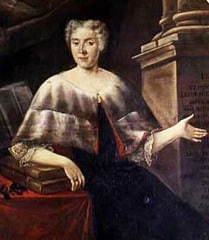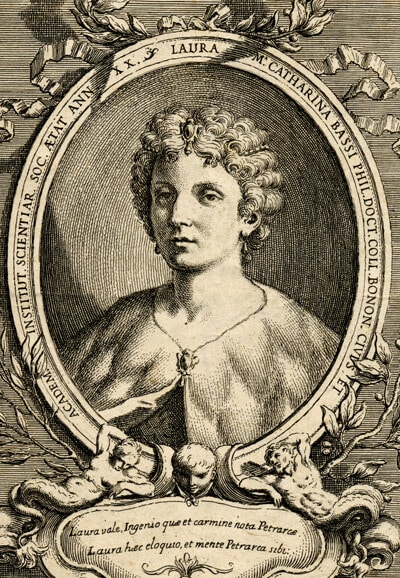Laura Bassi continuously fought to achieve equal conditions for women who chose an intellectual and professional career in public teaching and research institutions at a time when the universities and the world of academia in Italy and throughout the world were exclusively male environments. However, even the Pope was convinced and appointed her to the Academy of Sciences

Google likes to update us on the history of science, and this time it dedicated A doodle in memory of Laura Maria Katrina Bassi Verti (1711-1778) who was the first university professor in the world and was born in Bologna on October 29, 1711 and died there on January 20, 1778.
She received the position in 1732 after the Senate of the University of Bologna appointed her the chair of the physics department (then called natural philosophy), at a time when women were generally excluded from all intellectual professions and did not pursue higher studies. That year she also became the first woman elected to the Academy of the Institute of Sciences in Bologna.
Laura Bassi fought continuously to achieve equal conditions for women who chose an intellectual and professional career in public teaching and research institutions at a time when universities and the world of academia in Italy and throughout the world were exclusively male environments. The many studies conducted in the last years of her life emphasized the important role she played in Italy in spreading Newtonian physics and pioneering research on electricity.
Although she gave birth to eight children, she continued to teach and in 1776 was given the chair of experimental physics at the Institute of Science established by Marsili.
Her contemporaries saw her as a particularly smart woman, equally talented in Latin, logic, metaphysics, natural philosophy, algebra, geometry, Greek and French. She maintained contacts with the great scholars of her time, from Volta to Voltaire, as well as other illustrious names of the time, who came to Bologna and asked to get to know her.
She was not satisfied with one doctoral thesis but wrote 29 theses. The works of Laura Bassi, preserved in the Academy of Sciences in Bologna (one on chemistry, thirteen on physics, eleven on hydraulics, two on mathematics, one on mechanics and one on technology) testify to her role in the scientific debate of her time.
She also planned the marriage so that it would not interfere with her career

Bassi's achievements as an experimental scientist, professor, wife and mother were unprecedented, even in 18th century Italy which enjoyed a unique tradition of women scholars. Bassey was unusual in being the daughter of a middle-class family. She was educated at home by a male teacher who taught traditional classes in Aristotelian and Cartesian thought. She demonstrated her intellectual independence when she decided to investigate the new field of Newtonian physics.
In 1732, Bassi defended her works in Latin at the ceremony where the university awarded her the degree. The university recognized the importance of the event and distributed miniature paintings that decorate official documents. A silver coin was created in her honor that associated her with the Roman goddess of learning, Minerva. Political and religious figures attended the ceremony, including Cardinal Prospero Lambertini, and the future Pope Benedict XIV supported her.
.Bassi accepted a position as a lecturer in universal philosophy at the Institute and Academy of Sciences and Arts in Bologna, but was not allowed to teach in public without the approval of her male colleagues. They made sure to set a precedent that would encourage other women to aspire to careers as lecturers, as well as the daily presence of a young woman among them. Bassi responded by marrying the doctor Giuseppe Verti. She explained her decision: "I chose a person who follows the same learning path, and from long experience I was sure that he would not dissuade me from it."
The couple shared a home life, professional work and intellectual curiosity. They set up a laboratory in their home where they conducted experiments, especially on the effectiveness of electrical therapy. They also ran a private school for experimental physics that Bassi ran from 1749-1778. This allowed her to teach experimental physics, an opportunity the university denied her. Her courses attracted young students as well as adults interested in Newtonian science.
Bassey's knowledge of physics and mathematics, combined with her pioneering training in Newtonian theory, balanced the traditional approaches of her colleagues at the Institute. As a result, her private courses filled the academic void left by the institute, offering students innovative experimental physics lessons, and just as importantly, she became a key figure in the spread of Newtonian science in Italy. In 1750 she asked for a salary increase in recognition of her commitment to teaching experimental physics. In 1759 she was granted the addition. In 1745, Pope Benedict XIV increased the number of members in the Institute of Sciences, The Benedictine, in order to stimulate new scientific research in Bologna, according to the model of the Academy of Science in Paris. Twenty-four academicians were admitted to the academy Bandettini , and an allowance of 50 shoot It was awarded to them on the condition that they present one thesis per year based on a new scientific work. Bassey was not among the twenty-four scientists appointed by the Pope. She petitioned an influential friend to lobby the Pope to include her as well. The Pope created the 25th place for her.
However Bassi was denied full participation in Bendatini Because, as she wrote, "To always be alone in a gathering of men, and to hear all their conversations and quarrels, does not seem to suit the decency and modesty of women of her kind. . ” Bassey had just given birth to the fifth of her eight children when the discussions on her appointment took place.
When the position opened up for a new chairman of experimental physics, Bassey proposed her candidacy, and in 1776 she was appointed chairman and professor of the Institute of Experimental Physics, with her husband Verti as his assistant. She was sixty-five years old. She died suddenly two years later in 1778. Her husband continued to hold office and was followed by their son Paolo, who served until 1796.
The University of Bologna was known as the most advanced university in Europe In that it allowed the presence of women, especially those versed in the latest mathematical and experimental philosophies. Voltaire recognized this in a letter to Bassi in 1744. “There is no Bassi in London,” he wrote, “and I would be much happier to join your academy in Bologna than that of the English, even though it was created by Newton. "
Laura Bassi's achievements proved that women can study mathematics and physical sciences and go on to become successful scientific teachers and researchers.
More of the topic in Hayadan:
- The scientist who cracked the secret of radioactivity
- Rosalind Franklin - the scientist whose fame was stolen from her
- A male and female scientist send resumes to a biotechnology company
- 96 years since the birth of David Warren, the inventor of the black box
- Beatrice Tinsley (Beatrice Tinsley) - researcher of the expanding universe
